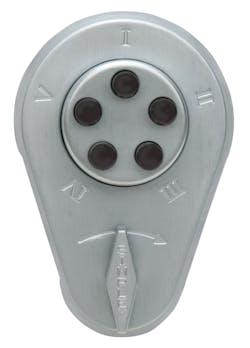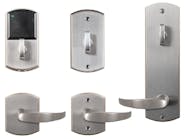Mechanical pushbutton locks were an early alternative to having to carry a key. A person would simply enter the single access code into the door lock mechanism. If the code was correct, the thumb turn, knob or lever could be rotated. The deadbolt or spring latch would retract and access could be gained.
A number of mechanical pushbutton locks have been developed over the last half century. From my limited research, the Kaba Ilco Unican 1800, introduced in 1965, is one of the oldest production pushbutton locks sold in North America. The original Unican handmade lock, dated 1964, is the Unican Model 29AMF.
Over the years, a number of manufacturers introduced their improved models of the mechanical pushbutton lock. Each lock manufacturer has their own design for the pushbuttons and the configuration of numbers and/or letters. Pushbutton locks can have as few as five buttons to more than a dozen. Early mechanical pushbutton lock buttons were arranged vertically or in a circle. Lock manufacturers would either use a chamber mechanism for all of the pushbuttons or each pushbutton would have its own the locking mechanism.
Most mechanical pushbutton locks are equipped with a conventional latchbolt or deadbolt enabling field reversibility. The numbers and/or letters can be read on left- or right-hand doors. Access codes vary depending upon the manufacturer and model of the locks. Most are from one to eight characters long.
Mechanical pushbutton entry locks have evolved over the years to include mortise locks, narrow stile aluminum glass door locks, gate locks and exit trim. Some pushbutton locks have mechanical key override.
The new LockeyUSA 2900 and 2950 mechanical pushbutton entry locks are designed for narrow stile aluminum doors. The 14-button LockeyUSA 2900 lock is equipped with a five-ply laminated steel pivot style bolt. A concealed hardened steel pin is built into the bolt for added security. The 2950 is equipped with the five-ply laminated steel hook pivot style bolt for sliding door applications.
Markets have opened for mechanical pushbutton cabinet locks and locker locks. The cabinet lock market has expanded to locking specialized cabinets that are maintained in mixed public areas. These can include emergency and medical equipment.
Commercial
In the 1980s, electronic pushbutton entry locks entered the commercial market. With the development of the microprocessor, battery powered and hardwired electronic pushbutton locks featured expanded user codes, time and date scheduling, and audit trail. For many of these electronic locks, the manufacturers incorporated the 12-pushbutton telephone style keypad.
Electronic door locks were originally limited to commercial application as the costs were prohibitive. In 1995, Weiser Lock introduced the Powerbolt electronic deadbolt. Around 2006, Schlage Lock introduced the residential battery operated pushbutton lock in both a deadbolt and an entry version. Schlage keypad locks features included up to 19 four-number User Codes that can be stored in a lock. All programming is relatively easy.
Residential
For residential locks, the advent of the electronic pushbutton offered the end user an opportunity to regain a level of security by operating the deadbolt via pushbuttons. Over the last couple of decades, children and adults seem to have difficulty locking the deadbolt lock when leaving. In some homes, if the entry lock is a passage model or not in the locked position, access to the home is as easy as pressing a lever or turning a knob. With an electronic door lock whose bolt can be thrown from the exterior, a person only has to press one or several buttons on the keypad to lock the electronic deadbolt.
Today, residential electronic deadbolt and entry locks are available from Arrow, Baldwin, Emtek, Kwikset, LockeyUSA, Schlage and Weiser to name a few.
Touchscreen
Although technically not a pushbutton style lock, Arrow Lock introduced the first touchscreen electronic lockset, the Revolution, in 2009. This capacitive sensitive display activates when a person’s had touches its screen. Once actived, a tone is sounded and the image of a 12-character telephone keypad appears on the display. Touching the display above an illuminated character is the same as pressing a button. The use of the touchscreen entry locksets has expanded to LockeyUSA, Schlage and Emtek.
Utility & Cabinet Locks
Electronic utility locks were not far behind. Electronic pushbutton cabinet door and drawer locks entered the market. Then came the electronic pushbutton safe locks.
In 2013, CompX introduced the RegulatoR push button cabinet door and drawer lock. This battery powered cabinet lock has two four- to eight-digit codes per lock, a user code and a supervisor code. It is available as a SlamCAM self-locking mechanism and manual lock. The SlamCAM spring loaded latch allows the user to push the door closed, automatically locking the lock. There is no need to close the door and turn the knob to the locked position.
The RegulatoR can be ordered in three cylinder lengths (7/16", 1-3/16" and 1-3/4") that are designed to fit into a ¾" diameter cam lock opening. Spacers provide additional latching dimensions. These cabinet locks are operated by two AAA batteries that provide a 25,000 plus operations. A low battery indicator notifies when the batteries need to be replaced. The battery compartment is accessible from outside of the cabinet.
Code Locks has introduced the KitLock Slam Latch for use with the KitLock KL1000 and KL1200 Locker electronic cabinet locks. These locks are equipped with 10-button keypad. There are four levels of codes: Master, Submaster, multiple user code and one-time user code (locker mode). The Master and Submaster are eight digits, whereas the user codes are four digits.
The KL1000 and KL1200 are designed to retrofit into cam lock door prep. Color options are available for the KL1000 and the KL1200. The KL1000 is available left and right hand horizontal, and vertical up. They are powered by two AAA batteries.
The KitLock Slam Latch allows the door to be pushed shut in order to lock. There is no need to turn the handle on the lock to secure the locker, cabinet or cupboard. These locks are adjustable for 1/8" to 1" thick wood or metal doors.
For more information, contact your local locksmith distributor or the following pushbutton lock manufacturers.
Alarm Lock: www.alarmlock.com
Arrow Lock: www.arrowlock.com
Baldwin: www.baldwinhardware.com
Code Locks: www.codelocks.us/
CompX: http://compx.com
Emtek: http://emtek.com
Kaba Ilco: www.kaba-ilco.com
Kwikset: www.kwikset.com
Lockey USA Inc ://lockeyusa.com
Sargent Lock: www.sargentlock.com
Schlage Lock: www.schlage.com
Weiser Lock: www.weiserlock.com





